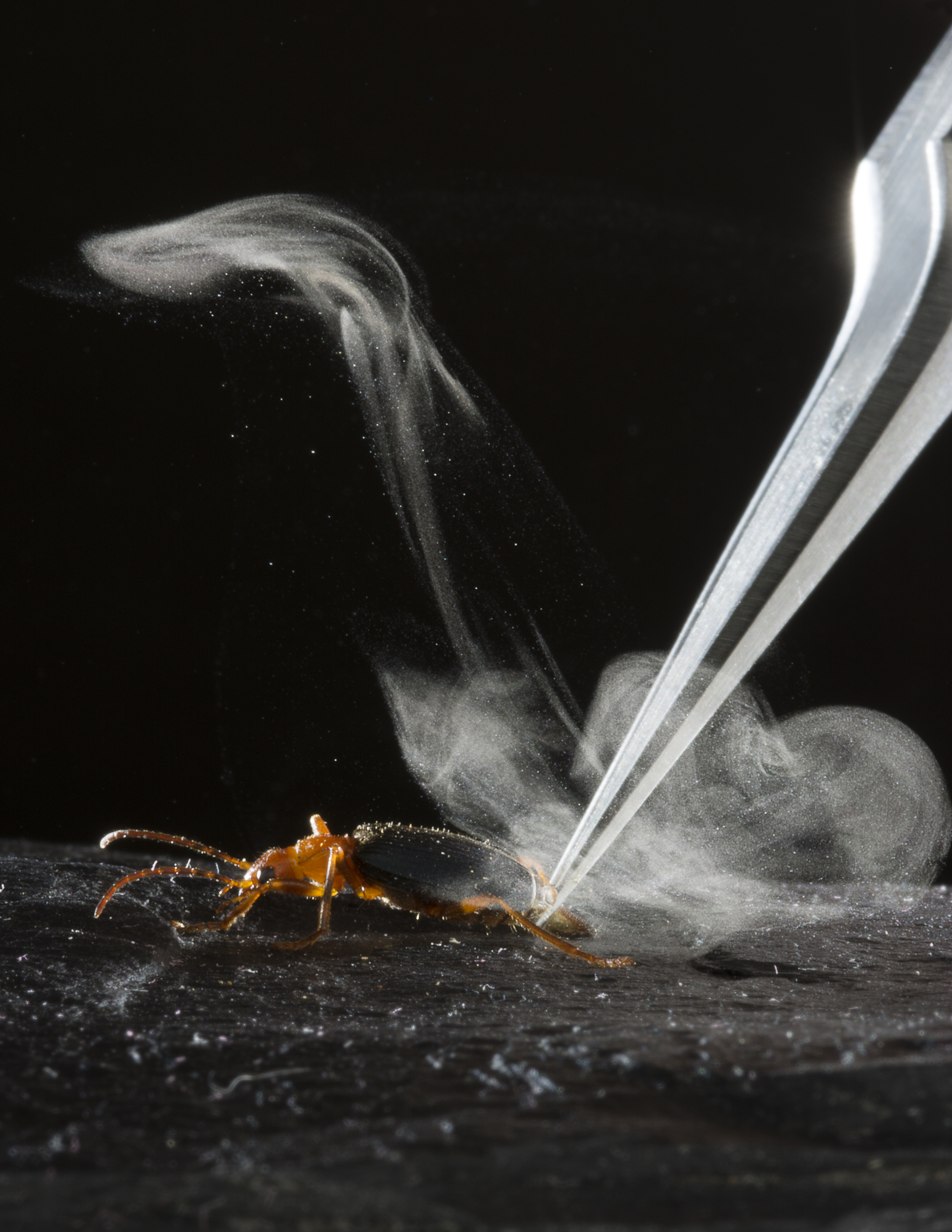How the Bombardier Beetle Packs Its Punch
Researchers have figured how a toxin-spraying beetle packs its pulsing punch.

The bombardier beetle pictured above (Brachinus elongatulus) has a pair of glands that each contain two chambers necessary for concocting an irritating spray. The chambers are composed of a cuticle—made up of chitin, proteins, waxes, and water—that can withstand the toxic chemicals, high temperatures, and elevated pressures that characterize the beetle’s explosive discharge. “It’s a very resilient and versatile material,” says researcher Eric Arndt. If this beetle sprays you, it won’t be extremely painful—but the chemicals will stain your hand brown like a henna tattoo. Photo by Charles Hedgcock © Wendy Moore
From the lizard that loses its tail to the opossum with its cunning corpse-like performances, prey have evolved myriad methods to wiggle out of harm’s way. But sometimes the most effective defense is a counterattack, such as the bold strategy employed by the bombardier beetle.
Members of this beetle subclass, which consists of more than 1,400 known species, deter predators with a burning hot, noxious secretion containing benzoquinone, a common toxin that is highly irritating to the skin, eyes, and respiratory system. The way they emit the spray varies, but around 500 species rapidly fire the seething solution. Like biological machine guns, these insects have been observed to discharge 300 to 1,000 rounds of the chemical each second, at speeds exceeding 22 miles/hour.
Since the bombardier beetle was first classified 250 years ago, its unique defense mechanism has captured the attention of naturalists and biologists. “But it wasn’t until 25 years ago that it was discovered that this spray [could come] out in a series of rapid pulses,” says Eric Arndt, a graduate student in materials science and engineering at MIT.
Although a handful of studies have attempted to solve the mystery of how bombardiers produce a pulsing spray, they relied solely on external observations, which left the underlying nuts and bolts largely unknown.
Arndt and a team of researchers decided to probe deeper, using high-speed X-ray imaging to study one bombardier species called Brachinus elongatulus. They recently published their findings in the journal Science.
The scientists investigated the insect’s pair of pygidial glands, each of which contains two chambers: a reservoir chamber that naturally produces and stores a reactant solution, and a reaction chamber where benzoquinone is synthesized and heated to 212°F.
“What we discovered was that a portion of the walls of the reaction chamber are thin and flexible, whereas [the rest] of the reaction chamber is mostly stiff,” says Arndt. “Most people assumed that the reaction took place in a fixed chamber.”
When the beetle is threatened, it contracts a small group of muscles within the pygidial gland that opens a valve, allowing a droplet of reactant solution—containing hydrogen peroxide and other organic compounds—to flow from the reservoir chamber into the reaction chamber. Here, the droplet mixes with a series of enzymes to form benzoquinone in an explosive reaction that boils the toxic spray and propels it from the tip of the insect’s abdomen directly at the encroaching threat.
The researchers found that the explosion increases pressure on the flexible wall of the reaction chamber, which expands and cuts off the flow of reactant solution through the connecting valve. After the explosion, the pressure decreases, allowing the valve to reopen, thereby initiating a new droplet cycle. The process continues—resulting in a series of pulsating ejections—until the beetle relaxes its muscles.
“Among all the insects, there are not very many examples of this kind of physical and chemical complexity,” says Arndt. “The bombardier beetle’s defense is extraordinarily effective against most vertebrate and invertebrate predators.”
Several animals have figured out how to outsmart the bombardier’s defenses, however. Blue jays and some other birds rub the beetle’s abdomen against their feathers or the sand, which serves to shield them until the insect is exhausted and curbs its barrage. Certain spiders have also been observed to wrap the beetle in silk to deflect the spray attack.
Arndt hopes to conduct similar experiments to learn more about bombardier defense mechanisms. “There are 540 other species of bombardier beetles that [rapidly] spray predators, and very little is known about them,” he says. “Any opportunity you have to study a system like this can serve as inspiration for design principles,” such as small lightweight propulsion systems.
Adam is a freelance science writer living in Brooklyn. He grew up in the Bay Area, where he developed a profound love of fog and tacos.